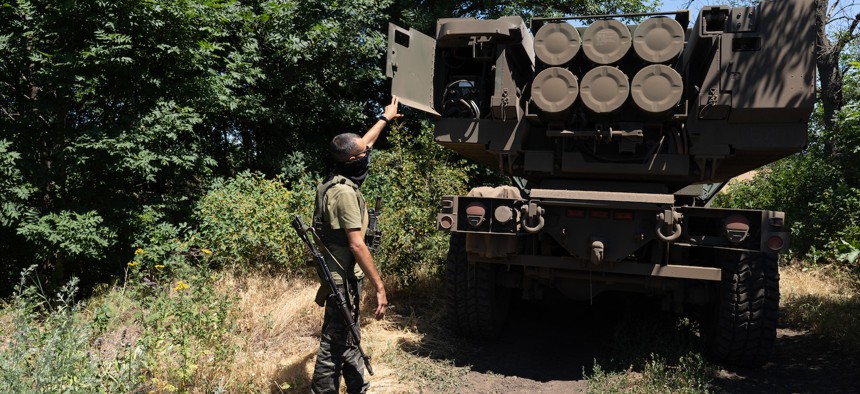
uzia, the commander of the unit, shows the rockets on HIMARS vehicle in Eastern Ukraine on July 1, 2022. Photo by Anastasia Vlasova for The Washington Post via Getty Images
Ukraine Says It Needs at Least 100 HIMARS and Longer-Range Rockets
More mobile artillery rocket systems, drones, and longer-range rockets would be a “game changer” said top Ukrainian defense official.
The recent addition of new long-range fires capabilities to Ukraine’s arsenal has played a key role in defending against stalled Russian forces. But additional mobile rocket batteries and longer-range rockets would allow Ukraine to mount more effective counter attacks and reclaim territory stolen by Russia, Oleksii Reznikov, minister of defense of Ukraine, said Tuesday.
Ukraine currently has eight High Mobility Artillery Rocket Systems, or HIMARS, able to strike ranges of 85 kilometers or 52 miles, as well asf Howitzer cannons with a range of 18 miles. Another four HIMARS are on the way as of last week, according to the Defense Department, and the White House expects to announce another shipment later this week. Speaking at an Atlantic Council event Tuesday, Reznikov said the HIMARS had already helped Ukraine destroy approximately 30 Russian command stations, as well as ammunition storage areas.
The mobile multiple rocket launchers have “significantly slowed down the Russian advance,” he said.
But in order to effectively protect Ukraine’s massive border and wage counter attacks on Russians occupying Ukrainian territory, they would need orders of magnitude more. “We would need at least 100 [HMARS] I think. That would become a game-changer on the battlefield,” he said, adding that Ukraine also needs ammunition retrieval and preparation systems for their 100 Howitzer cannons, as well as more UAVs to plot where to send long-range strikes.
“We are using HIMARS systems precisely, like…surgery, because we will not use the Russian strategy of, how we call, meat grinder,” he said, referring to the imprecise Russian shelling that has led to hundreds of civilian casualties.
John Herbst, a former U.S. ambassador to Ukraine, said HIMAR’s 85-kilometer range is “actually a little bit artificial,” and that it can be extended to at least 150 kilometers, which Reznikov said would be useful for hitting deeper into the Russian positions to attack resupply lines. But Reznikov has also said that he would not use the systems to attack Russian territory directly. The key to getting more launchers and rockets, he said, was demonstrating effective, responsible and “economical” use.
Herbst said the Biden administration has been too timid and risk averse in its willingness to send Ukraine longer-range weapons.
“Instead of giving you all the HIMARS you need and the longer ranges, they parceled it out in very small dosages,” he said.
Reznikov is optimistic that the Pentagon might expand the range of the weapons it’s willing to send, as it has already done multiple times since the start of the invasion.
“In November of 2021 I was told that we would never get [shoulder-fired FIM-92] Stingers because that simply wasn’t possible. It was forbidden… That story was repeated over and over again,” he said. “I believe that we will receive long-range weapons from our partners sooner or later.”
NEXT STORY: Self-Driving Cars Could Soon See Much Better




